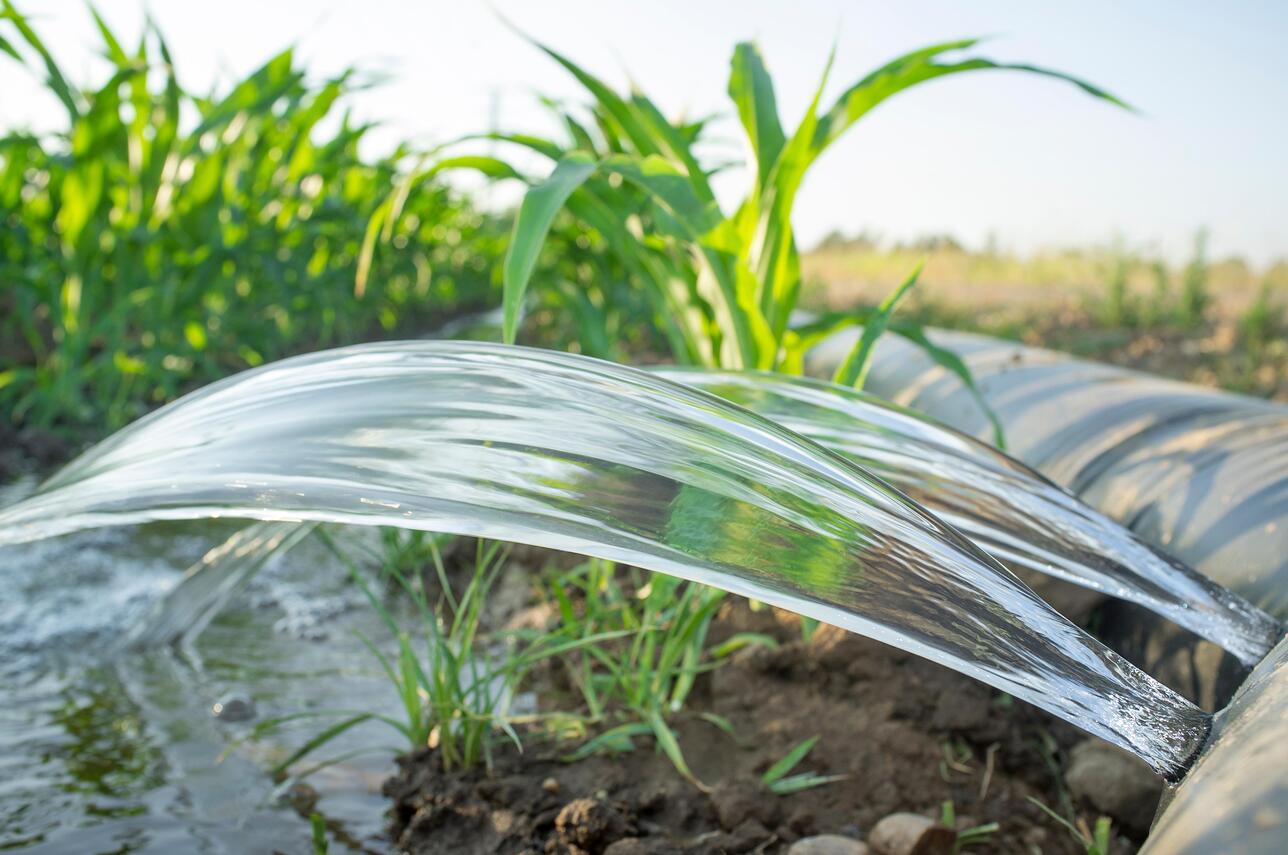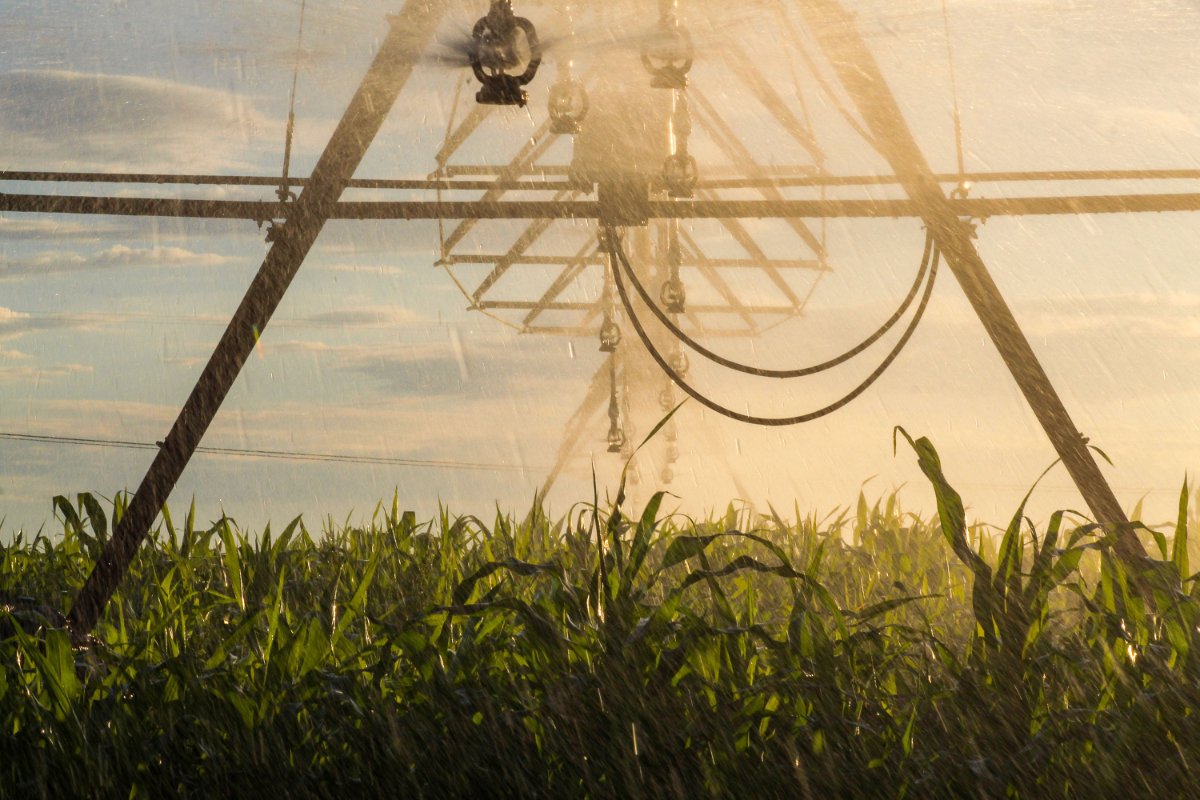Home>Gardening News and Trends>Latest News>How Did Irrigation Help Farmers During The Neolithic Revolution


Latest News
How Did Irrigation Help Farmers During The Neolithic Revolution
Modified: February 5, 2024
Discover the impact of irrigation during the Neolithic Revolution on farmers. Stay updated with the latest news on how this ancient technique revolutionized agriculture.
(Many of the links in this article redirect to a specific reviewed product. Your purchase of these products through affiliate links helps to generate commission for Chicagolandgardening.com, at no extra cost. Learn more)
Table of Contents
- Introduction
- Definition of the Neolithic Revolution
- Importance of Agriculture during the Neolithic Revolution
- Role of Irrigation in Agricultural Practices
- Benefits of Irrigation for Farmers
- Increased Crop Yield and Food Production through Irrigation
- Water Management and Conservation Techniques in Irrigation
- Expansion of Settlements and Development of Civilizations
- Challenges Faced by Farmers in Implementing Irrigation Systems
- Conclusion
Introduction
The Neolithic Revolution, also known as the Agricultural Revolution, was a turning point in human history. It marked the transition from a nomadic and hunter-gatherer lifestyle to a settled and agricultural way of life. This period, which began around 10,000 BCE, witnessed the emergence of farming communities and the cultivation of plants for sustenance.
Agriculture played a crucial role during the Neolithic Revolution, as it enabled early humans to produce their own food rather than relying solely on hunting and gathering. This shift in lifestyle had a profound impact on society, leading to the development of permanent settlements, the establishment of social structures, and the emergence of civilizations.
Among the many innovations that fueled agricultural practices during this period, irrigation stands out as a crucial development. Irrigation, which refers to the artificial application of water to crops or fields, played a fundamental role in supporting agriculture and improving crop productivity.
In this article, we will explore the significance of irrigation during the Neolithic Revolution and how it helped farmers in their agricultural pursuits. We will delve into the various benefits of irrigation, the techniques employed by early farmers to manage water resources, and the impact of irrigation on the expansion of settlements and the development of civilizations.
Join us as we delve into the fascinating world of irrigation and its role in transforming human civilization during the Neolithic Revolution.
Definition of the Neolithic Revolution
The Neolithic Revolution marks a significant shift in human history, characterized by the transition from a hunter-gatherer lifestyle to settled agricultural communities. It is considered a turning point in the development of human civilization, as it led to the establishment of permanent settlements and the emergence of agriculture as the primary means of subsistence.
Prior to the Neolithic Revolution, early humans relied on hunting animals and gathering wild plants for their survival. They led a nomadic lifestyle, constantly moving from one area to another in search of food. However, as the global climate changed and certain regions became more favorable for plant cultivation, humans began to experiment with farming practices.
The Neolithic Revolution is typically associated with the development of agriculture and the domestication of plants and animals. The ability to cultivate crops and rear animals provided a stable and reliable source of food. This led to population growth, as people were no longer solely reliant on the availability of wild resources.
The exact timeline and geographical spread of the Neolithic Revolution varied across different regions of the world. In some areas, such as the Fertile Crescent in the Middle East and the Nile River Valley in Egypt, the transition to agriculture occurred around 10,000 BCE. In other regions, such as China and the Americas, farming practices emerged later, around 7,000 to 5,000 BCE.
During this revolutionary period, early humans developed agricultural techniques such as seed selection, crop rotation, and the use of crude tools for tilling the land. These innovations, coupled with the advent of irrigation, allowed farmers to produce surplus crops, which could be stored and used during times of scarcity.
The Neolithic Revolution fundamentally changed the way societies were organized. It led to the establishment of permanent settlements, the development of social hierarchies, and the division of labor. It also laid the foundation for the emergence of complex civilizations, marking a significant milestone in human history.
Importance of Agriculture during the Neolithic Revolution
Agriculture played a pivotal role during the Neolithic Revolution by providing a stable and sustainable source of food for early human communities. This shift from a nomadic, hunter-gatherer lifestyle to settled agriculture had profound implications for the development of human civilization. Let’s explore the importance of agriculture during this transformative period.
1. Food Security: The Neolithic Revolution brought about a significant change in food production. Instead of relying solely on hunting animals and gathering wild plants, early humans began cultivating crops and domesticating animals. This shift provided a consistent and reliable food supply, reducing dependence on unpredictable sources of food. With the ability to produce their own food, communities became more resilient to fluctuations in environmental conditions.
2. Population Growth: The advent of agriculture led to a remarkable increase in population. With a stable food supply, communities were able to support larger populations. As a result, settlements grew in size, forming the foundation for the development of cities and complex societies. The ability to produce surplus food also allowed for the specialization of labor, as individuals could focus on tasks other than food procurement, such as crafts, trade, and governance.
3. Economic Development: Agriculture served as the cornerstone of economic development during the Neolithic Revolution. Surplus crops could be traded or exchanged for goods and services, leading to the emergence of early market systems. With an abundance of food, communities had the resources to engage in trade, which fostered cultural exchange, technological advancements, and the growth of economic networks.
4. Social Organization: The shift to agriculture brought about changes in social structures and organization. Settlements became more permanent, leading to the establishment of property rights and the development of social hierarchies. Agricultural surpluses allowed for the rise of elites, who managed the distribution of resources and assumed leadership roles within communities. Specialization of labor also led to the division of society into different professions and occupations.
5. Technological Advancements: The need to enhance agricultural productivity drove technological advancements during the Neolithic Revolution. Early farmers developed tools such as hoes, plows, and sickles to till the land, sow seeds, and harvest crops. Additionally, irrigation systems were created to regulate water supply to crops, improving yields and expanding arable land. These technological advancements laid the foundation for further innovation in agriculture and other areas of human development.
The importance of agriculture during the Neolithic Revolution cannot be overstated. It revolutionized human society, paving the way for advancements in technology, economic systems, and social organization. By embracing agriculture, early humans were able to secure food security, foster population growth, and lay the groundwork for the development of civilizations that would shape the course of human history.
Role of Irrigation in Agricultural Practices
Irrigation played a crucial role in supporting agricultural practices during the Neolithic Revolution. It was a revolutionary technique that allowed early farmers to control and manipulate water resources, ensuring the consistent supply of water to their crops. Let’s explore the significant role of irrigation in agricultural practices during this transformative period.
1. Water Management: One of the key roles of irrigation was efficient water management. By diverting and distributing water to crops, farmers were able to ensure that plants received the necessary amount of water for growth and development. This was particularly important in regions with limited rainfall or erratic precipitation patterns. Irrigation systems such as canals, ditches, and reservoirs were designed to capture and store water, allowing farmers to regulate the water supply and reduce dependence on natural rainfall.
2. Expansion of Arable Land: Irrigation facilitated the expansion of arable land by making previously unsuitable terrain suitable for cultivation. By redirecting water to dry or arid regions, early farmers were able to transform barren land into fertile agricultural fields. This expansion of arable land allowed for increased food production and the establishment of larger settlements.
3. Enhanced Crop Productivity: Irrigation significantly improved crop productivity during the Neolithic Revolution. Consistent and adequate water supply directly influenced the growth and yield of crops. With irrigation, farmers could provide water to crops even during dry spells, preventing crop failure. This resulted in higher crop yields, ensuring food security and surplus produce for trade, which further contributed to economic development.
4. Seasonal Crop Management: Irrigation enabled farmers to grow crops year-round, regardless of natural rainfall patterns. By creating irrigation schedules and effectively managing water resources, farmers could cultivate different crops in various seasons. This allowed for a diversity of crops, reducing the risk of crop failure and increasing overall agricultural output.
5. Soil Fertility and Nutrient Management: Irrigation systems also played a role in soil fertility and nutrient management. When water is applied to crops through irrigation, it carries nutrients and minerals from the soil, promoting healthy plant growth. Additionally, irrigation can help flush out excess salts and prevent soil salinization, which can be detrimental to crop growth. By maintaining proper soil fertility, irrigation contributed to sustainable agricultural practices during the Neolithic Revolution.
Irrigation was a game-changer for early farmers during the Neolithic Revolution. It provided them with the means to overcome the limitations of natural water availability, expand arable land, enhance crop productivity, and implement efficient water management techniques. The widespread adoption of irrigation systems transformed agriculture, paving the way for increased food production, population growth, and the development of civilizations.
Benefits of Irrigation for Farmers
Irrigation brought numerous benefits to farmers during the Neolithic Revolution, revolutionizing agricultural practices and leading to increased food production and societal development. Let’s explore the significant benefits that irrigation provided for early farmers during this transformative period.
1. Increased Crop Yield: One of the primary benefits of irrigation was the substantial increase in crop yield. By supplementing natural rainfall with controlled water supply, irrigation ensured that crops received enough water for optimal growth and development. This led to higher yields and a more reliable food supply. Farmers could cultivate larger quantities of crops, resulting in surpluses that could be stored, traded, or used as a buffer during times of drought or famine.
2. Year-Round Cultivation: Irrigation allowed farmers to cultivate crops throughout the year, regardless of the seasonal rainfall patterns. By providing a consistent water source, irrigation systems enabled farmers to grow multiple crops and achieve multiple harvests in a single year. This not only increased food production but also allowed for a diversified crop portfolio, reducing the risk of total crop failure due to adverse weather conditions.
3. Expansion of Agricultural Land: Another significant advantage of irrigation was the expansion of arable land. By channeling water to previously uncultivable areas, farmers could transform barren or dry land into productive agricultural fields. This expansion of agricultural land allowed for the establishment of larger settlements and the support of growing populations. It also contributed to the development of trade networks as surplus agricultural produce could be traded with other communities.
4. Mitigation of Climate Variability: Irrigation acted as a buffer against the effects of climate variability. In regions with unpredictable or insufficient rainfall, irrigation systems provided a reliable water source to farmers, mitigating the risks associated with droughts and erratic weather patterns. By managing water resources effectively, farmers could ensure continued crop growth and stabilize food production, even during adverse climatic conditions.
5. Improved Soil Fertility: Irrigation played a crucial role in maintaining and improving soil fertility. As water was applied to crops, it carried essential nutrients and minerals from the soil, promoting healthy plant growth. Additionally, irrigation helped flush out excess salts that could accumulate in the soil, preventing soil salinization and maintaining soil quality. This ensured the long-term sustainability of agricultural practices and supported the growth of healthy crops.
6. Control Over Water Supply: Irrigation systems gave farmers control over water distribution and usage. They could regulate the timing, amount, and distribution of water to suit the specific needs of different crops. This allowed for efficient water management, reducing water wastage and ensuring that crops received the optimal amount of water they needed for growth. Farmers could adapt their irrigation practices according to crop growth stages, saving water during early growth and increasing supply during critical growth periods.
The benefits of irrigation for early farmers during the Neolithic Revolution were immense. Increased crop yield, year-round cultivation, expansion of agricultural land, climate resilience, improved soil fertility, and control over water supply all contributed to enhanced food security, economic development, and the rise of complex societies. The adoption of irrigation systems reshaped agricultural practices and paved the way for the advancements that shaped the course of human civilization.
Increased Crop Yield and Food Production through Irrigation
Irrigation played a critical role in significantly increasing crop yield and food production during the Neolithic Revolution. By providing a controlled and reliable water supply to crops, irrigation systems revolutionized agricultural practices, ensuring optimal plant growth and higher yields. Let’s delve into how irrigation led to increased crop yield and food production during this transformative period.
1. Optimal Water Supply: Irrigation systems allowed farmers to provide crops with a consistent and optimal water supply. By delivering water directly to the roots of plants, irrigation ensured that crops received water exactly when and where they needed it. This resulted in enhanced growth and development, leading to increased crop yield. Irrigation allowed farmers to mitigate the risks associated with variable rainfall, ensuring that crops could thrive even during times of drought or insufficient rainfall.
2. Extended Growing Seasons: Via irrigation, farmers were able to extend the growing seasons and cultivate crops year-round. Unlike relying solely on rainfall, which is unpredictable and limited to specific seasons, irrigation allowed farmers to create favorable growing conditions regardless of the external climate. By providing water when necessary, farmers could cultivate crops beyond their natural growing seasons, leading to increased production and more frequent harvests.
3. Multiple Crop Harvests: With irrigation, farmers could cultivate multiple crops and achieve multiple harvests in a single year. By efficiently managing water resources, farmers could rotate crops or stagger planting times, allowing for continuous cultivation. This not only increased total food production but also provided a broader variety of crops for consumption and trade. The ability to obtain multiple crop harvests was a significant advantage for farmers, contributing to food security and economic prosperity.
4. Enhanced Farming Techniques: Irrigation systems led to the development of improved farming techniques that further increased crop yield. Farmers could optimize irrigation schedules, ensuring that crops received the right amount of water at each growth stage. This precision in water management maximized crop growth and minimized water wastage. Additionally, irrigation facilitated the adoption of other advanced farming practices, such as fertilization and pest control, which also contributed to increased crop productivity.
5. Surplus Food Production: The increased crop yield resulting from irrigation systems led to surplus food production. Farmers could produce more food than required for immediate consumption, creating a surplus that could be stored for future use or traded with neighboring communities. Surplus food production played a crucial role in sustaining growing populations, promoting economic activity, and fostering the development of trade networks.
6. Population Growth and Settlement Expansion: The ability to sustain larger populations through increased food production, thanks to irrigation, led to population growth and the expansion of settlements. With a stable and abundant food supply, settlements could support a greater number of individuals. The population growth and settlement expansion, in turn, facilitated further agricultural developments, technological innovations, and the development of complex societies.
Through the implementation of irrigation systems, early farmers during the Neolithic Revolution experienced a substantial increase in crop yield and food production. The controlled water supply provided by irrigation led to optimal plant growth, extended growing seasons, multiple crop harvests, enhanced farming techniques, surplus food production, and population growth. The adoption of irrigation systems revolutionized agriculture, paving the way for increased food security and societal developments that shaped human civilization as we know it.
Water Management and Conservation Techniques in Irrigation
Effective water management and conservation techniques were integral to the success of irrigation systems during the Neolithic Revolution. Early farmers recognized the importance of efficient water usage and implemented various strategies to optimize water resources. Let’s explore the water management and conservation techniques employed in irrigation during this transformative period.
1. Canals and Ditches: Canals and ditches were the primary means of water distribution in irrigation systems. Farmers dug channels that allowed water to flow from a water source, such as a river or reservoir, to their fields. By controlling the flow of water through these canals and ditches, farmers could ensure that the water reached all areas of their fields. This method facilitated efficient water distribution, minimizing water wastage and maximizing crop coverage.
2. Reservoirs and Storage Ponds: To store excess water during periods of abundant rainfall or high river flow, farmers constructed reservoirs and storage ponds. These artificial water storage structures allowed farmers to capture and store water for use during drier periods. By effectively managing water resources through storage, farmers could sustain their crops during droughts or reduce their dependence on irregular rainfall.
3. Furrow Irrigation: Furrow irrigation involved digging small channels or furrows between rows of crops. Water was then directed along the furrows, allowing it to seep into the soil and reach the plant roots. This technique reduced evaporation and ensured that water was targeted specifically to the plants, minimizing water wastage. Furrow irrigation was particularly effective for row crops and allowed for efficient water usage.
4. Basin Irrigation: Basin irrigation involved flooding the entire field with water and allowing it to slowly infiltrate the soil. This technique was suitable for areas with heavy clay soils, as the water could be absorbed and retained by the soil. Basin irrigation helped conserve water by reducing evaporation and ensuring that water penetrated deeply into the root zone of crops. It allowed for efficient water usage in areas where evaporation rates were high.
5. Terracing: In hilly or sloped regions, terracing was employed to prevent excessive runoff and soil erosion. Farmers created flat platforms or terraces along the slopes and arranged them in a step-like manner. These terraces helped to slow down water runoff, allowing it to be absorbed by the soil and benefit the crops. Terracing helped conserve water by preventing excessive loss due to runoff and promoted soil conservation, making the land more suitable for agricultural practices.
6. Mulching: Mulching, the practice of covering the soil surface with a layer of organic material, served as a water conservation technique. The mulch acted as a protective barrier, reducing evaporation and preventing weed growth. By conserving soil moisture, mulching helped to optimize water usage in irrigation systems, allowing farmers to irrigate less frequently while still providing sufficient moisture to the crops.
During the Neolithic Revolution, early farmers recognized the importance of water management and conservation in irrigation. Canals, ditches, reservoirs, furrow irrigation, basin irrigation, terracing, and mulching were among the techniques employed to optimize water resources. Implementing these strategies allowed farmers to maximize water usage, reduce water wastage, and ensure the long-term sustainability of their irrigation systems.
Expansion of Settlements and Development of Civilizations
The implementation of irrigation systems during the Neolithic Revolution played a crucial role in the expansion of settlements and the development of civilizations. The ability to control water resources through irrigation allowed early farmers to support larger populations, cultivate more land, and establish permanent settlements. Let’s explore how irrigation contributed to the expansion of settlements and the development of civilizations during this transformative period.
1. Increased Food Production: Irrigation systems significantly increased food production, providing a stable and reliable food supply for growing populations. With irrigation, farmers could produce higher crop yields and cultivate larger quantities of crops, resulting in surplus food. This surplus not only sustained growing populations but also facilitated the formation of larger settlements and the support of specialized roles beyond agriculture. Increased food production was an essential foundation for the growth and development of civilizations.
2. Population Growth: The availability of a consistent food supply through irrigation systems allowed for population growth. As food became more abundant, settlements could accommodate more individuals. As such, irrigated areas became attractive destinations for people seeking a stable food source, which led to the growth of these settlements. The increased population provided the human capital necessary for the development of divisions of labor, trade networks, and the emergence of specialized roles within society.
3. Specialization and Trade: The surplus food production made possible by irrigation systems allowed for specialization of labor. With a reliable food supply, not everyone needed to engage in agricultural activities, freeing up individuals to pursue other occupations. This led to the development of artisans, craftsmen, traders, and government officials. With the emergence of specialized roles, trade networks expanded, promoting economic growth and cultural exchange between settlements.
4. Social Complexity: The expansion of settlements due to irrigation systems led to the development of social complexity. Specialization of labor and increased population resulted in the formation of social hierarchies and the establishment of governing structures. With surplus resources from irrigation-based agriculture, rulers and the elite could maintain control and exercise authority. Social complexity laid the foundation for the formation of ancient civilizations such as Mesopotamia, Egypt, and the Indus Valley.
5. Technological Advancements: The need to manage and utilize water resources effectively in irrigation systems drove technological advancements. Early farmers developed various infrastructure and engineering techniques to distribute water, store it during surplus times, and prevent flooding during heavy rainfall. These advancements in irrigation technology not only improved agricultural practices but also laid the groundwork for further technological innovations in other fields like construction, transportation, and architecture.
6. Cultural and Intellectual Advancements: The development of settlements and civilizations enabled by irrigation systems fostered cultural and intellectual advancements. As populations concentrated in settlements, people had more opportunities for cultural exchange, leading to the development of art, architecture, written language, and religious practices. The surplus food production resulting from irrigation allowed individuals to explore intellectual pursuits beyond basic survival, leading to advancements in science, mathematics, and philosophy.
The expansion of settlements and the development of civilizations during the Neolithic Revolution were closely linked to the widespread adoption of irrigation systems. Through the increased food production, population growth, specialization and trade, social complexity, technological advancements, and cultural and intellectual pursuits made possible by irrigation, early farmers laid the groundwork for the development of complex societies that shaped human history.
Challenges Faced by Farmers in Implementing Irrigation Systems
While irrigation systems brought significant benefits to farmers during the Neolithic Revolution, their implementation was not without challenges. Early farmers encountered various obstacles as they sought to harness and manage water resources for agricultural purposes. Let’s explore some of the challenges faced by farmers in implementing irrigation systems during this transformative period.
1. Access to Water Sources: One of the primary challenges faced by farmers was ensuring access to reliable water sources for irrigation. Establishing a reliable water supply often required proximity to rivers, lakes, or underground water sources. Farmers had to identify suitable water sources and sometimes had to overcome geographical obstacles such as long distances or difficult terrain to transport water to their fields. The availability and proximity of water sources were critical factors in determining the viability of implementing irrigation systems.
2. Water Distribution: Another challenge was ensuring the efficient distribution of water throughout the agricultural fields. Farmers had to design and construct irrigation channels, canals, and ditches to transport water from the source to their crops. Proper layout and maintenance of these waterways were essential to prevent leakage, blockages, or uneven water distribution. Achieving an optimal water distribution required careful planning, engineering skills, and periodic maintenance efforts.
3. Engineering and Construction: Implementing irrigation systems required engineering and construction knowledge. Farmers had to design and construct infrastructure such as canals, dams, reservoirs, and water storage facilities. These constructions required expertise in managing water flow, preventing erosion, and building structures that could withstand the pressures exerted by water. The availability of suitable construction materials and resources further presented challenges, especially in regions with limited natural resources.
4. Water Management and Conservation: Farmers faced challenges in managing and conserving water resources effectively. Maintaining the appropriate water levels and ensuring efficient water usage were crucial for crop growth and preventing water wastage. Farmers had to develop strategies to manage water flow, minimize evaporation, and prevent waterlogging or drainage issues. Implementing proper water management techniques required knowledge of soil types, climate conditions, crop water requirements, and irrigation schedules.
5. Maintenance and Repair: Irrigation systems required regular maintenance and occasional repairs to ensure their continued functionality. With time, canals, ditches, and other infrastructure components could become damaged or overgrown by vegetation, leading to reduced water flow or blockages. Farmers had to invest time and effort in maintaining and repairing the irrigation infrastructure to keep the water distribution system functioning optimally. This required ongoing vigilance and physical labor to identify and address any issues promptly.
6. Environmental Impact: Implementing irrigation systems could have unintended environmental consequences. Poorly designed or managed systems could lead to waterlogging, soil salinization, or the depletion of water sources. These environmental challenges could negatively impact crop growth, soil fertility, and long-term sustainability. Farmers had to strike a balance between maximizing agricultural productivity and conserving natural resources, understanding the delicate equilibrium required to maintain a thriving ecosystem.
Despite the challenges posed by implementing irrigation systems, early farmers persevered and developed innovative solutions to overcome these obstacles. Their efforts laid the foundation for the widespread adoption of irrigation systems, which ultimately revolutionized agriculture and led to the development of complex human societies.
Conclusion
The implementation of irrigation systems during the Neolithic Revolution was a game-changer for early farmers and played a pivotal role in transforming human civilization. Irrigation systems provided a controlled and reliable water supply, leading to increased crop yield, expanded agricultural land, and the ability to support growing populations. These advancements led to the establishment of permanent settlements, the development of social structures, and the emergence of complex civilizations.
Through irrigation, early farmers overcame challenges such as access to water sources, water distribution, engineering and construction, water management and conservation, maintenance and repair, and the potential environmental impact. Their ingenuity and perseverance allowed them to harness and manage water resources effectively, revolutionizing agricultural practices and creating a sustainable food production system.
Irrigation systems offered numerous benefits for farmers during the Neolithic Revolution. They increased crop yield, ensured food security, supported population growth, facilitated specialization and trade, and fostered the development of social complexity and cultural advancements. These advancements laid the groundwork for the rise of civilizations and shaped the course of human history.
While the implementation of irrigation systems had its challenges, early farmers overcame them through knowledge, skill, and continuous innovation. Their ability to adapt and find solutions exemplifies the human drive to overcome obstacles and improve our way of life.
The legacy of irrigation systems from the Neolithic Revolution continues to be felt today. Modern agricultural practices heavily rely on irrigation to support large-scale food production and global food security. The lessons learned from the early farmers’ struggles and successes in implementing irrigation systems serve as a reminder of the importance of responsible water management and sustainable agricultural practices.
The impact of irrigation on human civilization during the Neolithic Revolution cannot be overstated. It transformed the way humans interacted with the environment, enabled the growth of settlements, and set the stage for societal advancements. The legacy of irrigation endures as a testament to the ingenuity and resourcefulness of early farmers, forever changing the course of human history.









